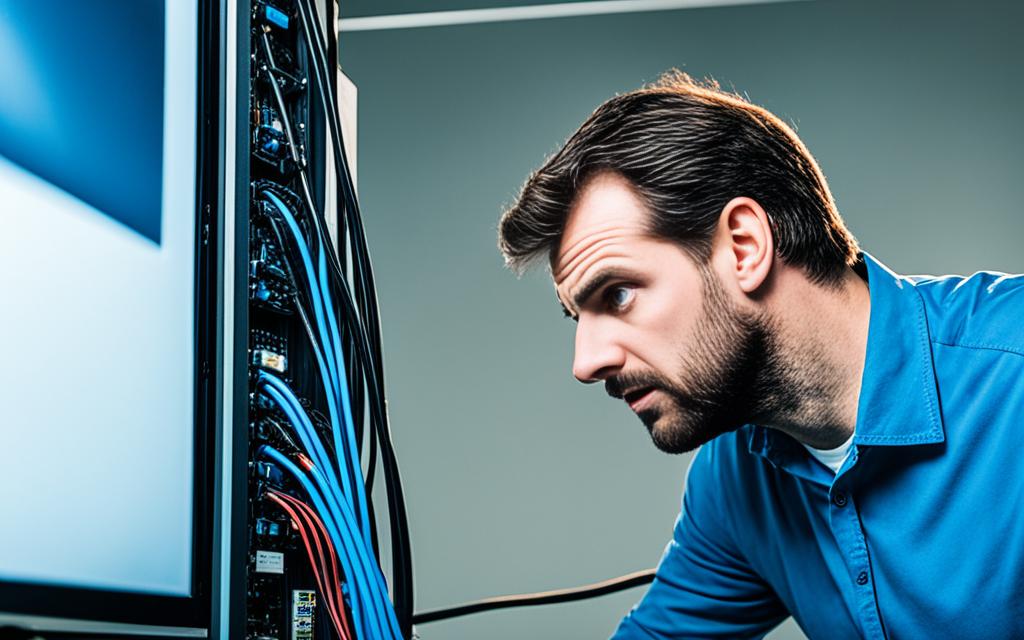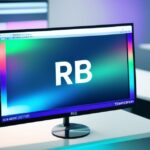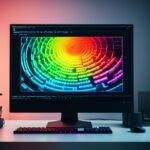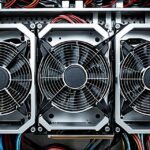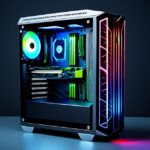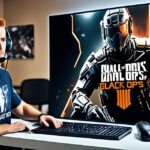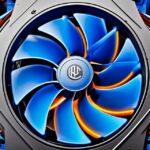Table of Contents
To find out if your PC is on, look for some clear signs. See if there are lights on your computer’s case. You should also listen for the sound of the fans. These signs mean your PC is getting power. Yet, your PC could still be on even if nothing shows on your screen. This issue might need more steps to figure out.
Seeing a black screen, even when your PC is on, could be for many reasons. It might be because of issues like bad connections, loose parts, or driver problems. It’s annoying when your computer seems to work but doesn’t show anything.
Start by checking the monitor. Make sure it’s on and correctly connected to your PC. Try adjusting its brightness and double-check the cables are firmly in place. Sometimes, fixing a black screen is as easy as these steps.
Secure Data Recovery gives tips for solving PC startup problems. These issues often come from power supply problems. Trying a different power outlet or changing the power cable might help. For laptops, let the battery charge a bit before turning it on.
Beep sounds can clue you into what’s wrong. These beeps help identify the problem’s source.
Looking at the BIOS/UEFI settings is crucial. If these settings are wrong, your PC might not start up properly. Using Safe Mode and disconnecting unnecessary devices can also help fix the issue. Make sure every component is properly attached.
Putting components back inside your PC carefully can often solve the issue. Sometimes, components come loose. Securing them back in place might fix the problem1.
Electrical shorts can stop your PC from working right. If this happens, you need to find and fix the shorts. Using a POST card or spare parts can help you find out which hardware part is causing trouble.
If your PC works with just the crucial parts like the motherboard, CPU, and RAM, then these parts are okay.
Completely restarting your PC can be part of troubleshooting. It ensures your PC fully powers up. Checking the monitor right away is also vital to avoid common problems.
For Windows 10 users, black screens have been especially problematic. Updating drivers or resetting BIOS settings might solve these graphics issues.
Key Takeaways:
- Check if the lights on your computer case are on and if you can hear the fans running to determine if your PC is powered on.
- A PC can turn on without displaying anything on the monitor, which requires further troubleshooting.
- Monitor issues, power supply problems, loose components, hardware malfunctions, and software conflicts can all prevent a PC from booting properly.
- Troubleshooting steps include checking power connections, adjusting display brightness settings, decrypting beep codes, and ensuring all components are securely attached.
- Reseating components, testing hardware, and troubleshooting graphics and software can help resolve common PC booting issues.
Troubleshooting the Monitor
If your computer turns on but your monitor shows nothing, it’s important to check the monitor first. This part will guide you through steps to find and fix common issues with monitors. With these tips, you can make your screen work again and avoid the stress.
Checking Power Sources and Cable Connections2
First, make sure your monitor is properly connected. Checking power and cables fixes half of monitor problems2. Check if the monitor is on. This is shown by a light on the monitor’s front or bottom. The light’s colour can change, such as to blue, green, or orange – based on the monitor.
If the monitor is on but the screen is still black, your computer might be asleep. Try to wake it by moving the mouse or pressing a key. If nothing shows up, try pressing the computer’s power button3.
A black screen could also mean a cable issue. Make sure the monitor’s cable is firmly plugged into the computer. This is important whether you’re using VGA, DisplayPort, DVI, or HDMI cables3. Also, check the power cable is in a working wall socket and the monitor shows a power light3.
Adjusting Screen Brightness and Display Inputs
Sometimes, fixing a monitor is as simple as changing its brightness. About 20% of issues can be solved this way2. Go into the monitor settings and adjust the brightness to see if it gets better.
Choosing the right display input is also key. This is the cause of 15% of monitor problems2. Make sure your monitor is set to the right input, like VGA, HDMI, or DisplayPort, based on your cable3.
Image: Troubleshooting a Monitor
Multi-Monitor Configuration and Beep Codes2
For those using more than one monitor, getting the settings right is crucial. Around 10% of issues come from setup mistakes in multi-monitor setups2. Make sure all monitors are set correctly in your computer’s settings.
Listening to beep sounds from your computer can also help. They make up 25% of troubleshooting cases2. These sounds indicate hardware issues and checking your motherboard’s manual can help find solutions.
With these troubleshooting steps, most monitor issues can be solved. Make sure to check your connections, adjust brightness, choose the right inputs, set up multiple monitors correctly, and listen for beep codes. Taking care of these points will fix most problems you might face with your monitor.
Common Fixes for PC Booting Issues
If your PC won’t start, don’t panic. Many solutions can help fix this issue. Here’s how to get your computer running again:
Check the Power Supply
Boot problems often come from a bad power supply. Your PC’s fans and lights might work, but it might not start. First, turn off your computer. Then check for electrical shorts and make sure cables are right4.Also, reseat the CPU and check the power supply’s voltage switch. This can fix power issues.
Boot in Safe Mode
New hardware or driver conflicts can cause issues. Safe mode might solve this by loading only basic drivers and services4.To enter safe mode, restart your PC and press F8 continuously. Then choose Safe Mode from the menu.
Unplug Unnecessary USB Devices
Before starting your PC, remove any extra USB devices4.Devices, especially in front USB ports, can stop your computer from booting. Unplugging them helps avoid these conflicts.
Listen for Beeping Sounds
Beeps during startup indicate problems. Each beep pattern shows a different issue4.Check your motherboard manual or website to understand these beeps. Then, you can fix the specific problem.
Reset BIOS Settings
Wrong BIOS settings might stop your PC from starting. Boot issues can arise from incorrect boot order or overclock settings4.Resetting BIOS to default can solve this. Check your motherboard’s guide for how to reset BIOS or use the Clear CMOS jumper.
Scan for Viruses without Booting into Windows
Malware can prevent your PC from booting. A live CD or USB can scan for viruses without starting Windows4.This stops malware from affecting the scan. Use a bootable antivirus disk to find and remove threats offline.
Monitor Hard Drive Corruption
Hard drive issues can also cause boot problems. Checking and fixing your hard drive for corruption is important4.Use disk checking tools regularly. This keeps your data safe and prevents startup issues.
Roll Back Problematic Windows Updates
New Windows updates might cause booting issues. If problems started after an update, you might need to undo these changes4.To do this, go to Windows Update settings, view update history, and uninstall recent updates.
Try these fixes to solve your PC booting problems. Check the power supply, use safe mode, unplug USB devices, listen for beeps, reset BIOS, scan for viruses without booting, check the hard drive, and undo recent updates. These tips can get your PC running smoothly again.
Troubleshooting Graphics and Software
If you’re having trouble with your computer’s display, it’s time to troubleshoot the graphics card and software.
Corrupted graphics drivers5 are a frequent issue. They let your computer and graphics card communicate. Reinstall your graphics drivers5 to fix this. You should uninstall the old drivers and get the latest ones from the manufacturer’s site. Make sure they match your system.
Incorrect BIOS settings5 could also cause problems. The BIOS manages your computer’s hardware settings. If the settings for your graphics card are wrong, the display might not work well. Resetting the BIOS to factory defaults5 could help. Do this by going to the BIOS menu when your computer starts.
If you can’t see the display, Windows Narrator might help5. It’s a tool that reads the screen out loud. It can help you navigate through the display settings.
Visual problems can be a sign of a dying GPU5. The GPU is key for creating the images on your screen. Signs like flickering or weird colours mean you should check your GPU’s health and look for solutions.
Overheating can hurt your GPU5. It can mess up your display. Try to cool it down to avoid this. You can change the fan settings or add more cooling5. This could mean faster fans, more fans, or better airflow in your PC.
Have you overclocked your GPU? If you see weird images, stop the overclocking5. Overclocking makes your GPU work faster than it’s supposed to, which can cause display issues.
New consoles are asking a lot from GPUs5. The demands of new games might be too much for some GPUs, leading to failures. If your display keeps having issues, think about getting a better graphics card5.
To find what’s wrong, try different troubleshooting steps5. You might restart the driver, try another monitor port, or use another GPU slot. The goal is to see if the graphics card or something else is the issue.
Uninstalling and then reinstalling GPU drivers can fix problems5. This makes sure the drivers are fresh. It often solves conflicts or bugs that hurt your display.
| Data | Statistics |
|---|---|
| Meeting minimum requirements | Running the game on the computer, not necessarily at the highest settings6 |
| Recent games and dedicated graphics cards | Most recent games may not run well or at all without a dedicated graphics card6 |
| Graphical tearing | Can occur when the game runs at a higher refresh rate than the monitor can handle6 |
| Artifacting | Where pixels change colors and stay that way, may indicate a graphics card under strain or hardware problem6 |
| Helpfulness of the article | 0% of players found the article helpful6 |
To fix display issues, troubleshoot your graphics card and software. Remember to update your drivers, check BIOS settings, and maybe get a new graphics card if you need it. These steps can help with any graphics or software problems, making your computer work better.
Checking Hardware Components
When fixing a PC, it’s key to check each part one by one. Faulty bits like the CPU, motherboard, RAM, power unit, or video card can cause big problems. This includes display issues and the system crashing. Make sure these parts sit tight and work right. Here are essential tips when examining hardware parts:7
1. CPU
The CPU is the computer’s brain, handling instructions and calculations. Pushing the CPU faster than its intended speed can increase performance. However, this comes with risks like instability or even breakdown. Choosing a stronger CPU, such as an Intel Core i7, could improve performance by up to 20%. This is great for tasks that need a lot of power like video editing7.
2. Motherboard
The motherboard links all PC components. Check it for damage or loose bits. You may need to replace the motherboard or get professional help if there’s an issue. It’s crucial to pick a motherboard that matches your CPU and other parts for the best performance7.
3. RAM
RAM is critical for your PC’s speed. You might need 12GB or 16GB of RAM for heavy-duty programs, while 8GB suffices for most uses. If you’re on 4GB or less, upgrading will let you run complex apps more smoothly7.
4. Power Supply
The power supply keeps your PC’s parts running. Make sure it connects properly and works as it should. A bad or weak power supply can make your system unstable or crash. A stronger power supply unit might be needed to support your components7.
5. Graphics Card
The graphics card brings images and videos to your screen. AMD and NVIDIA are big names in the market, with many card options. Basic video tasks use integrated graphics. For graphic problems, update your card drivers and check its connection. If you want better performance for big apps or games, think about getting a stronger card7.
Be careful when inspecting hardware and follow safety steps. If you’re not sure how to proceed, get in touch with support or seek a pro. This prevents any damage to your PC7.
Conclusion
Finding out if your PC is turned on needs you to look at both the hardware and software carefully. Start by checking for any signs that show it’s on, like lights or noise from the fan. If you see no signs of power, make sure the power cable is in tight. Then, try a different outlet. Also, look closely at the power button to check for damage.
Then, move on to the monitor and look at how it’s connected to the PC. If all looks good, try using a different monitor or connect the current one to another PC. This helps to figure out if the issue is with the monitor or the PC. If the monitor works fine, then the trouble might be inside the PC.
Sometimes, you may need to tackle issues that stop the computer from starting up properly. It could mean checking BIOS settings, resetting the CMOS, or even trying a system restore. If you’re not sure about these steps, it might be best to look up help online or get a professional.
By taking these steps and keeping an eye on the stats8910, you can figure out if your PC is working right. Solving issues might be a slow process. But don’t give up. If the problem doesn’t go away, getting professional help is a wise choice to find and fix the issue.
FAQ
How can I determine if my PC is powered on?
To find out if your PC is on, look for lights on the case and listen for fan sounds. A PC might be on even if nothing shows on the screen. This could mean there’s another problem. You’ll need to do more checks to be sure your PC is on.
What should I do if my computer powers on but there is no display on the monitor?
When your computer turns on but doesn’t show anything on the monitor, check the monitor first. Unplug it from the computer and turn it on alone to see if it shows anything. If the monitor works, it can display content. If it shows nothing, it might need fixing or replacing.
What could be causing my computer to show information on the monitor but not fully boot?
If your PC shows info on the monitor but won’t boot up, it could be a power issue. Restart your PC from off and check inside for any loose connections. Make sure cables are plugged in right. Moving the CPU slightly and checking your power supply’s setting could also fix it.
What should I do if I’m experiencing a black screen or display problems?
A black screen might mean your graphics drivers are outdated or corrupted. Try updating them to see if that fixes it. Wrong BIOS settings can also cause trouble. Resetting BIOS to default might help. Use features like Narrator in Windows to navigate without seeing the screen.
What should I check if the previous steps don’t resolve the issue?
If you’re still having issues, check each hardware piece by itself. Problems can come from loose or damaged parts like the CPU, motherboard, or RAM. Make sure everything is snugly connected. Look for any small, faulty parts too. If this seems too hard, consider asking for professional help or call customer support.
Source Links
- https://www.lifewire.com/fix-computer-that-turns-on-but-displays-nothing-2624443 – How to Fix a Computer That Turns on but Displays Nothing
- https://www.pcmag.com/how-to/what-to-do-when-your-computer-screen-wont-show-a-picture – What to Do When Your Computer Screen Won’t Show a Picture
- https://www.computerhope.com/issues/ch000241.htm – No Display or Black Screen on a Computer Monitor
- https://www.pcmag.com/how-to/what-to-do-when-computer-wont-start – Not Dead Yet: What to Do When Your Computer Won’t Start
- https://www.digitaltrends.com/computing/common-gpu-problems-how-to-fix/ – The Most Common GPU Problems and How to Fix Them | Digital Trends
- https://help.ea.com/en/help/pc/pc-graphics-troubleshooting/ – Troubleshooting graphics on PC
- https://www.avast.com/c-how-to-check-your-pc-specs – How to Check Specs on Windows PC
- https://www.currentware.com/blog/how-to-check-activity-on-computer/ – How Do I Check Recent Activity On My Computer? (& Staff PCs)
- https://haysethnography.weebly.com/conclusion.html – Conclusion
- https://techpaul.wordpress.com/2007/08/16/when-to-buy-a-new-computer-conclusion/ – When to buy a new computer, conclusion

